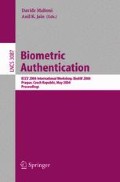Abstract
Alignment between the input and target objects has great impact on the performance of image analysis and recognition system, such as those for medical image and face recognition. Active Shape Models (ASM) [1] and Active Appearance Models (AAM) [2, 3] provide an important framework for this task. However, an effective method for the evaluation of ASM/AAM alignment results has been lacking. Without an alignment quality evaluation mechanism, a bad alignment cannot be identified and this can drop system performance.
In this paper, we propose a statistical learning approach for constructing an evaluation function for face alignment. A nonlinear classification function is learned from a set of positive (good alignment) and negative (bad alignment) training examples to effectively distinguish between qualified and un-qualified alignment results. The AdaBoost learning algorithm is used, where weak classifiers are constructed based on edge features and combined into a strong classifier. Several strong classifiers is learned in stages using bootstrap samples during the training, and are then used in cascade in the test. Experimental results demonstrate that the classification function learned using the proposed approach provides semantically more meaningful scoring than the reconstruction error used in AAM for classification between qualified and un-qualified face alignment.
Access this chapter
Tax calculation will be finalised at checkout
Purchases are for personal use only
Preview
Unable to display preview. Download preview PDF.
References
Cootes, T.F., Taylor, C.J., Cooper, D.H., Graham, J.: Active shape models: Their training and application. CVGIP: Image Understanding 61, 38–59 (1995)
Cootes, T.F., Edwards, G.J., Taylor, C.J.: Active appearance models. In: Burkhardt, H., Neumann, B. (eds.) ECCV 1998. LNCS, vol. 1407, pp. 484–498. Springer, Heidelberg (1998)
Edwards, G.J., Cootes, T.F., Taylor, C.J.: Face recognition using active appearance models. In: Proceedings of the European Conference on Computer Vision, vol. 2, pp. 581–695 (1998)
Cootes, T.F., , Taylor, C.J.: Statistical models of appearance for computer vision. Technical report (2001), www.isbe.man.ac.uk/~bim/refs.html
Schapire, R.E., Singer, Y.: Improved boosting algorithms using confidence-rated predictions. In: Proceedings of the Eleventh Annual Conference on Computational Learning Theory, pp. 80–91 (1998)
Friedman, J., Hastie, T., Tibshirani, R.: Additive logistic regression: a statistical view of boosting. The Annals of Statistics 28, 337–374 (2000)
Viola, P., Jones, M.: Robust real time object detection. In: IEEE ICCV Workshop on Statistical and Computational Theories of Vision, Vancouver, Canada (2001)
Sclaroff, S., Isidoro, J.: Active blobs. In: Proceedings of IEEE International Conference on Computer Vision, Bombay, India (1998)
Friedman, J.: Greedy function approximation: A gradient boosting machine. The Annals of Statistics 29 (2001)
Mason, L., Baxter, J., Bartlett, P., Frean, M.: Functional gradient techniques for combining hypotheses. In: Smola, A., Bartlett, P., Schölkopf, B., Schuurmans, D. (eds.) Advances in Large Margin Classifiers, pp. 221–247. MIT Press, Cambridge (1999)
Zemel, R., Pitassi, T.: A gradient-based boosting algorithm for regression problems. In: Advances in Neural Information Processing Systems, vol. 13, MIT Press, Cambridge (2001)
Schapire, R., Freund, Y., Bartlett, P., Lee, W.S.: Boosting the margin: A new explanation for the effectiveness of voting methods. The Annals of Statistics 26, 1651–1686 (1998)
Freund, Y., Schapire, R.: A decision-theoretic generalization of on-line learning and an application to boosting. Journal of Computer and System Sciences 55, 119–139 (1997)
Author information
Authors and Affiliations
Editor information
Editors and Affiliations
Rights and permissions
Copyright information
© 2004 Springer-Verlag Berlin Heidelberg
About this paper
Cite this paper
Huang, X., Li, S.Z., Wang, Y. (2004). Statistical Learning of Evaluation Function for ASM/AAM Image Alignment. In: Maltoni, D., Jain, A.K. (eds) Biometric Authentication. BioAW 2004. Lecture Notes in Computer Science, vol 3087. Springer, Berlin, Heidelberg. https://doi.org/10.1007/978-3-540-25976-3_5
Download citation
DOI: https://doi.org/10.1007/978-3-540-25976-3_5
Publisher Name: Springer, Berlin, Heidelberg
Print ISBN: 978-3-540-22499-0
Online ISBN: 978-3-540-25976-3
eBook Packages: Springer Book Archive

